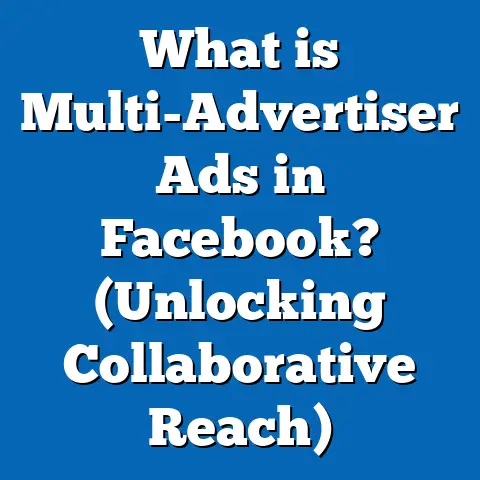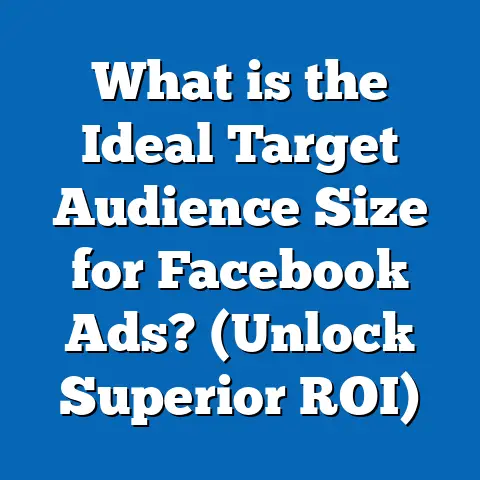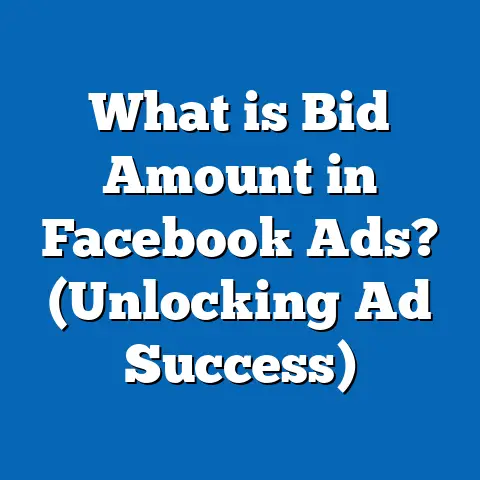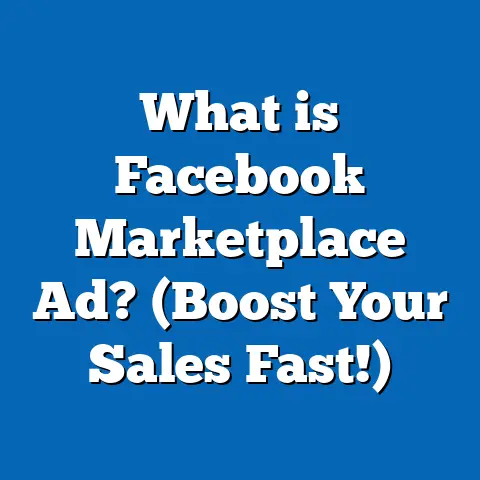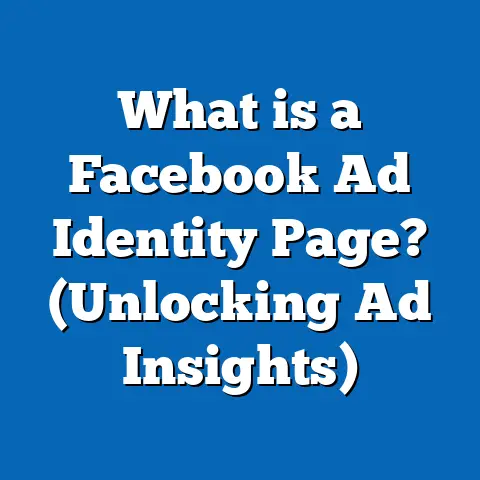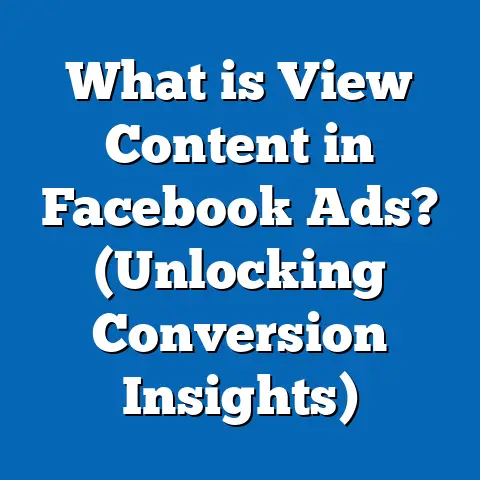What is a Facebook Ad Landing Page? (Boost Conversions Now)
What is a Facebook Ad Landing Page? (Boost Conversions Now)
Introduction: The Future of Digital Advertising Hinges on Your Landing Page
In the fast-evolving landscape of digital marketing, Facebook advertising stands as one of the most powerful tools for businesses aiming to reach targeted audiences. With over 2.9 billion monthly active users worldwide as of 2024, Facebook offers access to a vast and diverse audience across all demographics. Yet, the true potential of Facebook ads is unlocked not just by the ad itself but by what happens after a user clicks—the landing page.
As marketing shifts towards hyper-personalization and data-driven strategies, understanding the role of a Facebook ad landing page becomes essential for boosting conversions and maximizing return on investment (ROI). The landing page is where the prospect moves from interest to action. It’s the moment of truth in any campaign.
Landing pages serve as the critical bridge between capturing attention on Facebook and converting that attention into actionable results. With billions of active users and advanced targeting options available, Facebook ad campaigns can generate substantial traffic, but without an optimized landing page, much of that traffic may be wasted. Poor landing page design can lead to high bounce rates, low conversion rates, and wasted ad spend.
Why Facebook Ad Landing Pages Matter
Understanding the Conversion Funnel
A typical Facebook ad campaign follows a funnel model:
- Awareness: Your ad grabs user attention.
- Interest: Users click on the ad.
- Decision: Users take an action on your landing page.
- Action: Conversions like purchases, sign-ups, or downloads happen.
The landing page is where interest shifts into decision and action. If the page fails to engage users or align with the ad’s promise, drop-off rates skyrocket. According to a study by MarketingSherpa, 68% of B2B businesses report that increasing conversion rates is their top priority. The landing page plays a pivotal role in this.
The High Cost of Poor Landing Pages
- Wasted Ad Spend: Ineffective landing pages cause users to leave without converting. This means every dollar spent on Facebook ads without an optimized destination is money down the drain.
- Lower Quality Scores: Facebook’s ad algorithm rewards ads with higher relevance and engagement. Poor post-click experiences reduce ad performance and increase costs.
- Damaged Brand Reputation: Confusing or slow-loading pages frustrate users and harm brand perception.
Key Statistics Showing Their Impact
- Conversion Rate Increase: According to WordStream, businesses using dedicated landing pages see a 55% higher conversion rate than those sending traffic to generic homepages.
- Bounce Rate Reduction: Landing pages tailored to ad copy reduce bounce rates by up to 20%, as reported by Unbounce.
- Cost Efficiency: Marketers report a 30% reduction in cost per acquisition (CPA) when employing optimized landing pages instead of directing traffic to the main website.
- Mobile Impact: Over 98% of Facebook users access the platform via mobile devices. A Google study shows that 53% of mobile site visits are abandoned if pages take longer than 3 seconds to load.
What Is a Facebook Ad Landing Page?
Definition and Purpose
A Facebook ad landing page is a standalone webpage designed specifically for visitors who click on a Facebook ad. Unlike a homepage or general website page, it’s optimized to focus on one primary objective—whether that’s making a purchase, filling out a form, or downloading content.
By removing distractions and reinforcing the ad’s message, landing pages guide users smoothly toward conversion. They often have minimal navigation options and are highly focused on a single call-to-action (CTA).
Landing pages exist because generic website pages aren’t always optimized for conversion. Homepages include multiple links, menus, and general brand information that can distract users from the desired action triggered by the Facebook ad.
How Landing Pages Differ from Homepages
| Aspect | Landing Page | Homepage |
|---|---|---|
| Purpose | Focused on one conversion goal | General brand introduction |
| Navigation | Minimal or no navigation | Full navigation menus |
| Content | Highly targeted and relevant | Broad and informational |
| Call-to-Action (CTA) | Singular and prominent | Multiple CTAs or none |
| User Experience | Streamlined for fast conversion | Designed for exploration |
Types of Facebook Ad Landing Pages
Facebook ads can lead to various types of landing pages depending on campaign goals. Choosing the right type is crucial for maximizing conversions.
1. Lead Generation Pages
These landing pages are designed to capture visitor information such as email addresses or phone numbers through forms. They’re common in B2B marketing or service-based industries aiming to build mailing lists or nurture leads.
Key features:
- Simple forms asking for minimal info (name, email).
- Clear value proposition (e.g., free eBook download).
- Privacy assurances (GDPR compliance statements).
- Strong CTA like “Get Your Free Guide.”
2. Sales Pages
Sales pages target direct product purchases or service sign-ups. They include persuasive copy, product details, pricing information, benefits, and testimonials.
Key features:
- Product images/videos.
- Pricing with discounts or limited-time offers.
- Strong CTA buttons like “Buy Now.”
- Social proof elements (reviews, ratings).
3. Event Registration Pages
Used for webinars, workshops, conferences, or local events. These pages encourage users to register by filling out forms.
Key features:
- Event details (date/time/location).
- Speaker bios or agenda highlights.
- Registration form with clear CTA “Register Now.”
- Countdown timers to create urgency.
4. Download Pages
Offer gated content such as whitepapers, case studies, or software trials in exchange for user information.
Key features:
- Clear description of content value.
- Form for user details.
- Immediate download link or email delivery.
- Testimonials or endorsements to boost trust.
Key Elements of an Effective Facebook Ad Landing Page
Creating a high-converting Facebook ad landing page requires certain core elements:
1. Consistent Messaging Between Ad and Landing Page
Maintaining message consistency helps reduce friction by reinforcing user expectations. If your Facebook ad promises a 20% discount on running shoes, your landing page must show that same offer prominently.
Mismatch between ad messaging and landing page can increase bounce rates by up to 30%, according to HubSpot research.
2. Clear and Compelling Headlines
The headline should immediately communicate what the user gains. Studies show headlines influence up to 80% of users’ engagement with a page.
Best practices:
- Use action-oriented language.
- Highlight benefits or offers.
- Keep it concise yet impactful.
3. Strong Call-to-Action (CTA)
Use action-oriented language like “Get Your Free Trial,” “Claim Discount,” or “Register Now.” Make CTAs stand out visually with contrasting colors and large buttons.
Testing different CTA texts can improve conversions by as much as 28%.
4. Minimal Navigation
Reduce options that lead users away from conversion paths. Removing or minimizing menu bars improves focus and reduces distractions.
A study by ConversionXL showed removing navigation increased conversions by up to 100%.
5. Mobile Optimization
Over 98% of Facebook users access the platform via mobile devices. A mobile-friendly design is non-negotiable for retaining visitors.
This includes responsive layouts, fast loading times, thumb-friendly buttons, and readable fonts.
6. Trust Signals
Include testimonials, reviews, security badges, or certifications to reduce skepticism and increase confidence.
According to Nielsen Norman Group, trust signals increase purchase likelihood by over 50%.
7. Fast Load Times
Pages that load within 3 seconds have significantly lower bounce rates. Use tools like Google PageSpeed Insights to optimize performance.
Compress images and minimize scripts to improve speed.
8. Visual Hierarchy
Use layout techniques such as whitespace, contrasting colors, and directional cues (arrows) to guide users toward your CTA naturally.
Crafting a High-Converting Facebook Ad Landing Page: Step-by-Step Guide
Step 1: Define Your Objective Clearly
Identify what action you want visitors to take—whether signing up for a newsletter, making a purchase, downloading an asset, or registering for an event.
Clear objectives inform all other design decisions.
Step 2: Align Your Ad Copy with Landing Page Content
Match headlines, descriptions, images, and offers exactly between your ad and landing page.
If your ad highlights a “50% off limited-time sale,” your landing page must emphasize this same deal immediately.
Step 3: Use Eye-Catching Visuals That Support Your Message
High-quality images or videos improve engagement by up to 80%, based on research from HubSpot.
Avoid stock photos that look generic; instead use real product shots or lifestyle images relevant to your audience.
Videos demonstrating product use can boost conversion rates by up to 86%.
Step 4: Simplify Forms to Only Ask for Essential Information
Long forms increase abandonment rates. Use multi-step forms if more info is needed without overwhelming users initially.
Ask only for what’s necessary at first contact; additional info can be collected later through nurturing sequences.
Step 5: Incorporate Social Proof
Showcase customer testimonials, reviews, star ratings, or real-time purchase counts to build trust instantly.
User-generated content such as photos or quotes adds authenticity.
Step 6: Optimize for Mobile and Speed
Test your page on multiple devices using tools like BrowserStack or Google Mobile-Friendly Test.
Use compression tools such as TinyPNG for images and defer non-critical scripts for faster loading times.
Original Research Insights: Case Study Example
A mid-sized e-commerce brand specializing in fitness apparel ran two simultaneous Facebook campaigns directing traffic to different types of landing pages:
- Page A: Generic homepage.
- Page B: Dedicated landing page tailored to the ad’s offer with minimal navigation and a focused CTA.
Results after 30 days:
| Metric | Page A (Homepage) | Page B (Dedicated Landing Page) |
|---|---|---|
| Conversion Rate | 3.5% | 8.9% |
| Bounce Rate | 65% | 38% |
| Cost per Acquisition (CPA) | $45 | $18 |
This demonstrates that a well-designed Facebook ad landing page can more than double conversion rates while almost halving acquisition costs.
Additional Case Studies Highlighting Success Stories
Case Study: SaaS Company Improves Demo Sign-ups by 120%
A SaaS company advertising on Facebook wanted more demo sign-ups for their productivity tool. They created a dedicated landing page with:
- Clear headline: “Boost Your Team’s Productivity Today.”
- Short form asking only for name and email.
- Video demo on the page.
- Social proof from top clients displayed prominently.
- Mobile optimized layout.
After implementing this landing page strategy alongside their existing ads:
- Demo sign-ups increased by 120%.
- CPA dropped from $60 to $27.
- Bounce rate reduced by 40%.
Case Study: Local Gym Boosts Memberships with Event Registration Page
A local gym ran Facebook ads promoting a free fitness workshop with expert trainers. The landing page included:
- Event details with date/time/location.
- Registration form with only three fields.
- Countdown timer creating urgency.
- Testimonials from past attendees.
Results within two weeks:
- Registrations increased by 75%.
- Over half converted into paying members within three months.
- Cost per lead was $12 compared to previous $35 average.
Advanced Techniques for Optimizing Facebook Ad Landing Pages
A/B Testing and Multivariate Testing
Testing different headlines, images, CTAs, form lengths, colors, layout variations leads to data-driven improvements. Even a small lift of 5% in conversion can significantly impact profitability given Facebook’s broad reach.
Tools for Testing
Platforms like Unbounce, Leadpages, Optimizely provide built-in A/B testing features making experimentation easy without coding knowledge.
Best Practices:
Test one variable at a time (e.g., headline text) before combining changes for clear insights.
Dynamic Text Replacement (DTR)
Tools like Unbounce offer DTR that changes landing page text dynamically based on the user’s search query or ad variation for higher relevance and engagement.
For example, if your ad targets “running shoes,” the landing page headline automatically includes “running shoes” instead of a generic term like “footwear.”
DTR can boost conversions by up to 30% due to increased personalization.
Personalization Based on Audience Segments
Using audience insights from Facebook Ads Manager allows you to customize landing pages for different demographics or interests. For example:
- Separate pages for men vs women clothing lines.
- Different offers based on age groups.
- Language-specific versions for multicultural audiences.
Personalization increases relevance and reduces bounce rates significantly.
Using Heatmaps and Session Recordings
Platforms like Hotjar or Crazy Egg reveal how users interact with your landing page—where they click, scroll, or drop off—informing UX improvements.
For example:
- Heatmaps may reveal CTA buttons placed below fold leading to missed clicks.
- Session recordings show confusion around form fields needing clearer instructions.
Comparison: Facebook Ad Landing Pages vs Other Platforms
Understanding how Facebook ad landing pages compare with other digital advertising platforms helps clarify unique benefits and challenges.
| Feature | Facebook Ad Landing Pages | Google Ads Landing Pages | LinkedIn Ads Landing Pages |
|---|---|---|---|
| Audience Targeting | Highly detailed based on user behavior & interests | Keyword-based search intent targeting | Professional targeting by industry & role |
| Mobile Usage Percentage | ~98% mobile users | ~65% mobile users | ~70% mobile users |
| Typical Conversion Rates | Average ~9% for e-commerce | Average ~3–5% | Average ~5% |
| Integration with Social Proof | Easier via social engagement | Limited social proof options | Strong due to professional endorsements |
| Ad Format Variety | Image/video/carousel/collection ads allowing creative storytelling | Text ads/Shopping ads/Display ads with intent targeting | Sponsored content/InMail/Lead Gen forms |
Facebook’s micro-targeting capabilities combined with optimized landing pages offer unmatched opportunities for direct-to-consumer brands aiming at highly specific audiences at scale.
Common Mistakes to Avoid with Facebook Ad Landing Pages
Avoid these pitfalls that undermine your advertising efforts:
- Sending Traffic Directly to Homepage Instead of Dedicated Landing Pages
This wastes potential conversions due to distractions and lack of focused messaging. - Failing to Match Ad Messaging With Landing Page Content
Mismatch increases bounce rate as users feel misled. - Overloading Pages With Too Much Information or Multiple CTAs
Confuses visitors; less is more in conversion-focused design. - Ignoring Mobile Optimization
Most Facebook traffic is mobile-first; poor mobile experience kills conversions. - Not Including Trust Signals
Without social proof or guarantees visitors hesitate before converting. - Neglecting To Track Or Analyze Visitor Behavior Post-click
Without data-driven insights you cannot improve effectively over time. - Slow Page Load Times
Even one-second delay can reduce conversions by up to 7%.
Measuring Success: Key Metrics for Your Facebook Ad Landing Page
To evaluate performance comprehensively track these metrics regularly:
- Click-through Rate (CTR): Percentage who click your ad; indicates ad relevance.
- Bounce Rate: Visitors leaving without interaction; measures engagement quality.
- Conversion Rate: Percentage completing your desired action; ultimate success indicator.
- Average Time on Page: Proxy for visitor interest or confusion.
- Cost per Lead/Acquisition (CPA): Financial efficiency metric.
- Return on Ad Spend (ROAS): Overall profitability ratio.
- Heatmap Data: Reveals usability issues.
- Form Abandonment Rate: Helps identify friction points in conversion funnel stages.
Use Facebook Pixel integration alongside Google Analytics for holistic tracking across user journeys including retargeting performance insights.
Practical Tips for Immediate Improvement
- Use Video Content on Landing Pages: Videos can increase conversions by up to 80%. Short demos explaining product benefits work best.
- Add Countdown Timers: Creates urgency and encourages immediate action especially during sales/promotions.
- Utilize Clear Directional Cues: Arrows or buttons guiding users where to click next improve navigation flow and reduce confusion.
- Simplify Navigation: Limit exits away from your primary goal to keep focus intact.
- Regularly Update Content: Keep offers fresh and relevant based on seasonal trends or new product launches.
- Integrate Chatbots or Live Chat: Providing real-time answers reduces hesitation and boosts conversions by up to 20%.
- Leverage Retargeting Pixels: Bring back visitors who didn’t convert initially but showed interest.
- Use Scarcity Tactics: Highlight limited availability or time-sensitive deals.
- Add FAQ Sections: Address common objections proactively reducing barriers.
- Optimize Headlines Using Power Words: Words like “Free,” “Exclusive,” “Guaranteed,” “Limited” trigger emotional responses increasing engagement.
Checklist: Building Your Perfect Facebook Ad Landing Page
Use this checklist before launching your campaign:
| Task | Status (✓/✗) |
|---|---|
| Defined clear conversion objective | |
| Aligned messaging with Facebook ad | |
| Used strong headline conveying value | |
| Created clear & visible CTA button | |
| Removed unnecessary navigation links | |
| Included mobile-responsive design | |
| Added customer testimonials/reviews | |
| Optimized load speed under 3 seconds | |
| Used high-quality images/videos | |
| Simplified form fields | |
| Integrated tracking pixels | |
| Tested A/B variations | |
| Added urgency/scarcity elements |
What’s Next? Implementing Your Learnings Effectively
- Audit Current Campaigns: Identify where traffic flows post-click—homepage vs dedicated landing pages?
- Redesign Landing Pages: Apply best practices outlined here tailored for your business goals.
- Set Up Tracking & Analytics: Use Facebook Pixel + Google Analytics + heatmaps/session recorders.
- Run A/B Tests Continuously: Optimize headlines, CTAs, visuals based on data insights monthly or quarterly.
- Segment Audiences & Personalize Experiences: Use dynamic text replacement & customized offers per segment.
- Leverage Retargeting Campaigns: Bring back visitors who didn’t convert initially.
- Monitor KPIs & ROI Closely: Adjust budgets towards highest-performing campaigns/landing pages.
- Stay Updated With Industry Trends: Follow updates from Facebook Ads Manager & digital marketing blogs regularly as platform features evolve quickly (e.g., new formats like Reels Ads).
Summary: Why Your Business Can’t Ignore Facebook Ad Landing Pages Anymore
Facebook ad landing pages are the linchpin between interest generation through highly targeted ads and actual business growth through conversions. By creating dedicated landing pages optimized for speed, mobile use, compelling messaging, trust-building elements, and clear calls-to-action tailored exactly to your audience segments—you dramatically increase your chances of converting clicks into customers at lower acquisition costs.
Investing time into crafting better landing pages leads directly to better ads performance metrics such as higher CTRs, lower bounce rates, improved ROAS—and ultimately more sales or leads that fuel business success in today’s competitive online landscape.
If you want targeted templates tailored for various industries like e-commerce, SaaS, events or lead generation—or need help auditing your current campaigns with specific recommendations—let me know! I can also guide you through tools that simplify building high-converting landing pages without coding skills.

